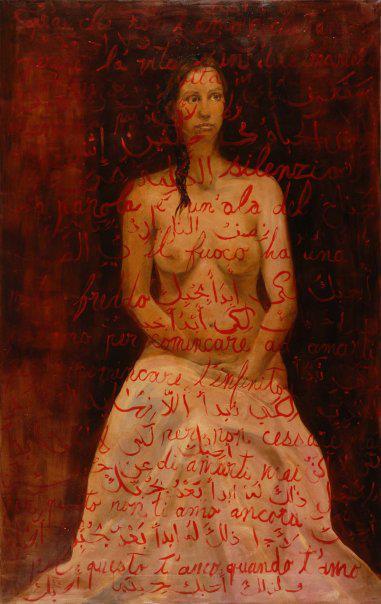
A painting by Iraqi artist Hadeel Azeez on Arab Women Artists.

A painting by Iraqi artist Hadeel Azeez on Arab Women Artists.
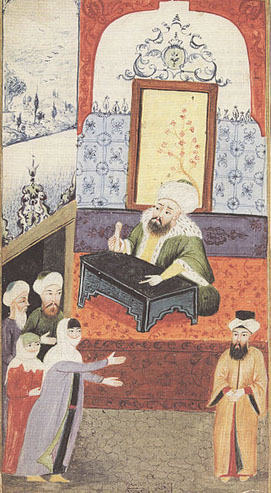
An unhappy wife is complaining to the Qadi about her husband’s impotence, 18th century.
Fresh Air, NPR, April 16, 2012
Sadakat Kadri is an English barrister, a Muslim by birth and a historian. His first book, The Trial, was an extensive survey of the Western criminal judicial system, detailing more than 4,000 years of courtroom antics.
In his new book, Heaven on Earth, Kadri turns his sights east, to centuries of Shariah law. The first parts of his book describe how early Islamic scholars codified — and then modified — the code that would govern how people lead their daily lives. Kadri then turns to the modern day, reflecting on the lawmakers who are trying to prohibit Shariah law in a dozen states, as well as his encounters with scholars and imams in India, Pakistan, Syria, Egypt, Turkey and Iran — the very people who strictly interpret the religious and moral code of Islam today. And some of those modern interpretations, he says, are much more rigid — and much more draconian — than the code set forth during the early years of Islamic law. Continue reading Interpreting Shariah Law Across The Centuries
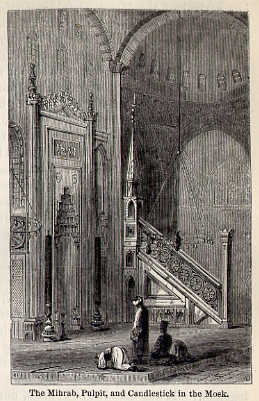
I have recently published an article in a volume edited by Ian Netton, entitled Orientalism Revisited: Art, Land and Voyage (London: Routledge, 2013, pp. 187-204). I provide the introductory paragraphs below.
Orientalism and Bibliolatry:
Framing the Holy Land in 19th Century Protestant Bible Customs Texts
“The Orient was almost a European invention, and has been since antiquity a place of romance, exotic beings, haunting memories and landscapes, remarkable experiences.†Edward Said, Orientalism, 1979
“In a word, Palestine is one vast tablet whereupon God’s messages to men have been drawn, and graven deep in living characters by the Great Publisher of glad tidings, to be seen and read of all to the end of time.†William M. Thomson, The Land and the Book, 1859
This essay begins with a famous opening phrase from Edward Said’s Orientalism not because there is a need to validate or dispute it, but because of what it leaves out. Indeed, Said’s caveat of “almost†is telling, since his text only describes the “Orient†invented through the writings of Western writers. What is remarkable about Said’s styling of the Orient as a form of politicized discourse is that the most important part of this invention is missing: the Orient invaded by Napoleon is also the Holy Land, the “vast tablet,†as American missionary William Thomson phrases it, which brings the Bible to life. Napoleon may have initiated Western imperialist ambitions in this Holy Land, but the ultimate failure of his military mission stands in stark contrast to the perpetual array of Christian pilgrims, scholars and missionaries who visited this holiest of Holy Lands for Christians and Jews. Absent from Said’s text is the genre that was most widely read in 19th century Europe and America, specifically Holy Land travel texts that cited contemporary customs and manners of Arabs and other groups encountered as illustrations of Bible characters for popular consumption, especially among Protestants.
Said’s genealogy of the discourse he identifies as Orientalism is a thoroughly academic one. Continue reading Orientalism and Bibliolatry:
Framing the Holy Land in 19th Century Protestant Bible Customs Texts
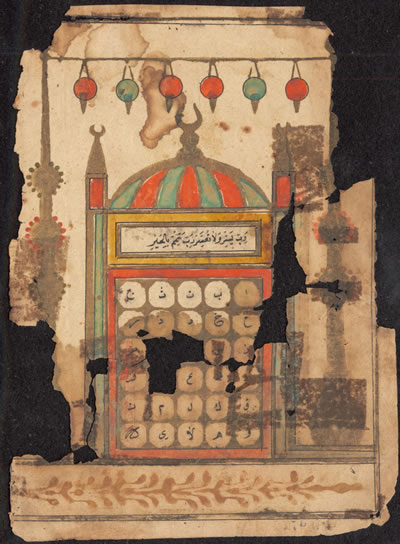
Arabic Paper #0972, University of Utah- J. Willard Marriott Library
by Anouar Majid, Tingis Redux, January 31st, 2013
After reading Jonathan Bloom’s splendid book Paper Before Print: The History and Impact of Paper in the Islamic World, published more than decade ago, I now think that there is a close relationship between Islam as we know it and the discovery of paper by Arabs in the 8th century. I also understand why natives of Tangier in Morocco call paper “kaghit.†Since it was the Chinese who invented paper some 2000 years ago, the Muslims who conquered Central Asia in the 8th century used that term, which was borrowed from the Persian kaghaz, itself originating from the Chinese guzhi.
The Muslims adopted paper with gusto and the technology of papermaking soon spread in Iraq, Syria, Egypt, North Africa and Spain. Europeans learned papermaking from the Moors who established the first paper mills in Spain. Paper eventually facilitated the printing process that was started by Johann Gutenberg in 15th-century Germany.
According to Muslim sources, the first Muslim paper mill was established in 8th century Baghdad either by the Abbasid caliph al-Mansur or by Harun al-Rashid. Regardless of who claims the honor, the use of paper soon led to the establishment of a Stationers’ Market (Souk al-Warraqeen). By the 12th century, according to one account, the Moroccan city of Fez had some 472 paper mills. No wonder papermaking has been associated with Arabs and Arabic. When one talks about “reams†of paper, one is using an Arabic term—rizma, which means bundle—via the Spanish resma and Old French rayme.
The discovery of paper by Arabs led to a major revolution in human civilization. Until then, most documents outside Asia were written on parchments (dried animal skins) or papyrus rolls—both laborious and expensive processes. Paper was easier to use. The Abbasids lost no time in making use of it to enhance their standing among world civilizations. They established a House of Wisdom (bayt al-hikma), commissioned the translations of foreign works in Greek, Hindu and Persian, wrote down the Hadith and codified Islamic law from what had been a mostly oral tradition. Libraries grew and played a major role in the dissemination of knowledge. The Shiite dynasty of the Fatimids in Egypt had an annual budget for library collections and activities. Continue reading Islam: The Chinese Connection

Artwork by Lebanese artist Fady Habib
By George N. El-Hage. Ph.D.
[Originally written in Arabic and Translated by Allen Lederman and George Nicolas El-Hage. For part 1, click here.]
1 – Glory be to Lebanon and the strength and dignity of man in her, now and forever.
2 – Oh my Lebanese friend, if only you could witness the politicians, and by God they are many. Those who deprived politics of its national obligations, you will see them as they are, without their chameleon skins, parrot tongues, and raven cloaks. If only you saw them in the mirror of truth and patriotism, you would curse them and refuse their sedition.
3 – Because Lebanon embodies love, and love embodies God, Lebanon endures. Fear not, oh Lebanese.
4 – No. The sound of the cannons and the explosions of the bombs and bullets no longer frighten our women. For the Woman who reared history’s greatest heroes is able to beget heroism any time.
5 – Those who died in the cause of Lebanon know they live in our hearts and that to die for Lebanon, is to live.
6 – Never have invaders and oppressors been more powerful than a people fighting for its survival. Thus we know we will triumph and endure.
7 – Those who sold their homeland and bartered their cause do not even deserve the curse of history, for he who has neither country nor cause, is non-existent.
8 – Those whom Lebanon harbored and fed, and carried their cause to the world, chased her people out, starved and killed them. We will continue to love them, for what good is it to love only those who love you. Continue reading Lebanese Hymns of Love and War- Part 2
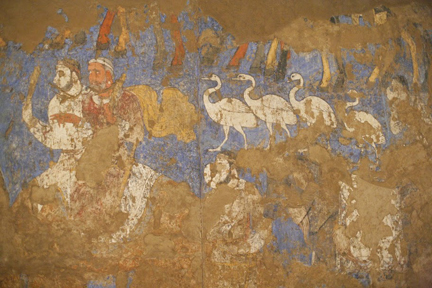
Colloquium at Hofstra University
Art and Archaeology of Central Asia: Works in Progress
Saturday, January 26, Breslin Hall 105
Session I
11:00 am – 12:45 pm
Michael D. Frachetti
Washington University in St. Louis
Agriculture and Mining among Highland Mobile Pastoralists of Semirech’e (3000 – 1500 BCE)
Claudia Chang
Sweet Briar College, Virginia
Progress on the Archaeological Researches
on Iron Age settlements on the Talgar Fan
Perry Tourtellotte
Sweet Briar College, Virginia
Mortuary and Settlement Landscapes of the Iron Age:
Talgar Fan and Beyond
Lunch
12:45 pm – 1:30 pm
Session II
1:30 pm – 4:15 pm
Pavel Lurje
Hermitage Museum, St Petersburg, Russia
Personal Names throughout the History of Chorasmia
Fiona Kidd
Metropolitan Museum of Art, New York
Some New Thoughts on the Procession Scene
in the Paintings of Akchakhan-kala
Anna Feuerbach
Hofstra University
Recent Research on Industrial Remains at Ancient Merv Continue reading Central Asia Archaeology Conference at Hofstra
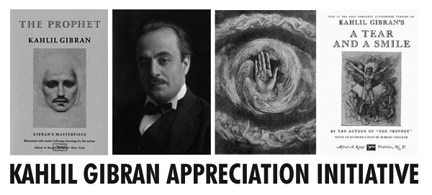
Sign the Petition for a Kahlil Gibran US Postage Stamp!
Why Gibran?
Since his passing, fans of Gibran Kahlil Gibran (1883-1931) have called for a fitting tribute to the poet, author, artist, and philosopher, who remains one of the most renowned figures in the world literary landscape. For Arab Americans and Arabs daunted by political, financial and social uncertainty, Gibran holds a valuable place as the immigrant voice in America. Arab Americans and Arabs have long ago claimed Gibran’s achievements as their own, proudly holding his life and works close to their hearts.
Perhaps this protective emotional engulfing has to do partly with Gibran’s own quest to belong. Early on in his childhood, the Lebanese born poet was rendered homeless after his father was sent to prison for tax evasion, and his property was impounded. Shortly thereafter, the family emigrated to Boston’s South End, where non-English speaking Gibran was told he should Anglicize his name, and refer to himself simply as Kahlil Gibran. Continue reading Petition for a Kahlil Gibran US Postage Stamp
[This is the second in a series of poems translated from the Arabic of George Nicolas El-Hage’s If You Were Mine. For the first installment, and information about the poet, click here.]
Exile
My unbelief and sins and faith
And black cares watch over me
September and March come
And I am in my room, collapsing
A nightmare wears my sorrows …
It comes to me also, comes to me
News, my dark one, threw me
Into your eyes’ hollow it threw me …
Other years I wait
December and January …
The room swells in my breast
I die slowly …
The room swells in my breast
I live through seasons, unaware,
That exile is my country.
Continue reading George Nicolas El-Hage: If you were mine, 2